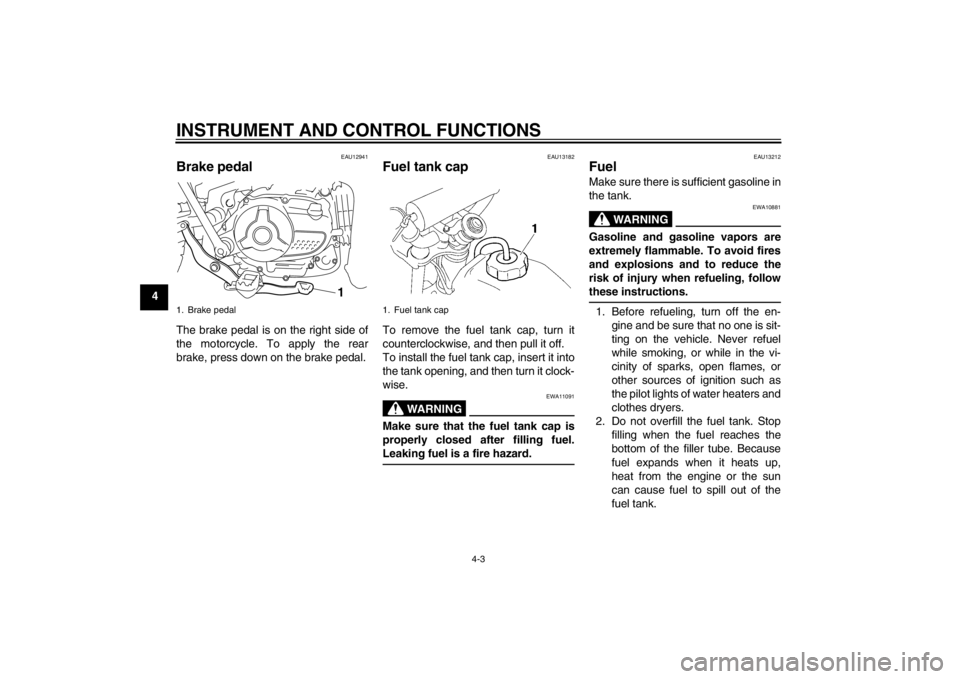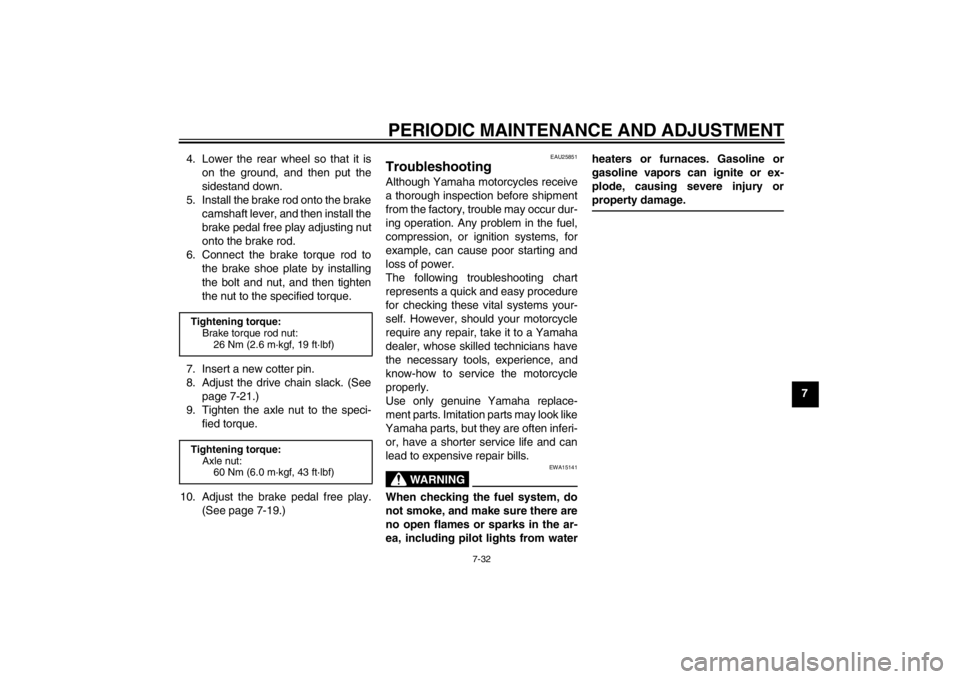brake light YAMAHA TTR110 2013 Owners Manual
[x] Cancel search | Manufacturer: YAMAHA, Model Year: 2013, Model line: TTR110, Model: YAMAHA TTR110 2013Pages: 88, PDF Size: 2.02 MB
Page 30 of 88

INSTRUMENT AND CONTROL FUNCTIONS
4-3
4
EAU12941
Brake pedal The brake pedal is on the right side of
the motorcycle. To apply the rear
brake, press down on the brake pedal.
EAU13182
Fuel tank cap To remove the fuel tank cap, turn it
counterclockwise, and then pull it off.
To install the fuel tank cap, insert it into
the tank opening, and then turn it clock-
wise.
WARNING
EWA11091
Make sure that the fuel tank cap is
properly closed after filling fuel.
Leaking fuel is a fire hazard.
EAU13212
Fuel Make sure there is sufficient gasoline in
the tank.
WARNING
EWA10881
Gasoline and gasoline vapors are
extremely flammable. To avoid fires
and explosions and to reduce the
risk of injury when refueling, follow
these instructions.1. Before refueling, turn off the en-gine and be sure that no one is sit-
ting on the vehicle. Never refuel
while smoking, or while in the vi-
cinity of sparks, open flames, or
other sources of ignition such as
the pilot lights of water heaters and
clothes dryers.
2. Do not overfill the fuel tank. Stop filling when the fuel reaches the
bottom of the filler tube. Because
fuel expands when it heats up,
heat from the engine or the sun
can cause fuel to spill out of the
fuel tank.
1. Brake pedal
1
1. Fuel tank cap
U5B685E0.book Page 3 Tuesday, July 10, 2012 5:06 PM
Page 48 of 88

PERIODIC MAINTENANCE AND ADJUSTMENT
7-5
7
8 Drive chain Check chain slack/alignment and condition.
Adjust and lubricate chain with Yamaha chain and cable
lube thoroughly. Every ride
9 *Steering bearings Check bearing assemblies for looseness.
Moderately repack with lit
hium-soap-based grease. √√
10 *Chassis fasteners Check all chassis fitting and fasteners.
Correct if necessary. √√√
11 Brake lever pivot shaft Apply lithium-soap-based grease lightly. √√
12 Brake pedal pivot shaft Apply lithium-soap-based grease lightly. √√
13 Sidestand pivot Check operation.
Apply lithium-soap-based grease lightly. √√
14 *Front fork Check operation and for oil leakage.
Replace if necessary. √√
15 *Shock absorber assem-
bly Check operation and for oil leakage.
Replace if necessary.
√
16 *Control cables Apply Yamaha chain and cable lube or engine oil thor-
oughly. √√√
17 *Throttle grip Check operation.
Check throttle grip free play, and adjust if necessary.
Lubricate cable and grip housing. √√√
No. ITEM CHECKS AND MAINTENANCE JOBS
INITIAL ODOMETER READINGS
1000 km
(600 mi) or
1 month or 30 hours 3000 km
(1800 mi) or
6 months or 90 hours 5000 km
(3000 mi) or
12 months or 150 hours
U5B685E0.book Page 5 Tuesday, July 10, 2012 5:06 PM
Page 75 of 88

PERIODIC MAINTENANCE AND ADJUSTMENT
7-32
7
4. Lower the rear wheel so that it is
on the ground, and then put the
sidestand down.
5. Install the brake rod onto the brake camshaft lever, and then install the
brake pedal free play adjusting nut
onto the brake rod.
6. Connect the brake torque rod to the brake shoe plate by installing
the bolt and nut, and then tighten
the nut to the specified torque.
7. Insert a new cotter pin.
8. Adjust the drive chain slack. (See page 7-21.)
9. Tighten the axle nut to the speci- fied torque.
10. Adjust the brake pedal free play. (See page 7-19.)
EAU25851
Troubleshooting Although Yamaha motorcycles receive
a thorough inspection before shipment
from the factory, trouble may occur dur-
ing operation. Any problem in the fuel,
compression, or ignition systems, for
example, can cause poor starting and
loss of power.
The following troubleshooting chart
represents a quick and easy procedure
for checking these vital systems your-
self. However, should your motorcycle
require any repair, take it to a Yamaha
dealer, whose skilled technicians have
the necessary tools, experience, and
know-how to service the motorcycle
properly.
Use only genuine Yamaha replace-
ment parts. Imitation parts may look like
Yamaha parts, but they are often inferi-
or, have a shorter service life and can
lead to expensive repair bills.
WARNING
EWA15141
When checking the fuel system, do
not smoke, and make sure there are
no open flames or sparks in the ar-
ea, including pilot lights from water heaters or furnaces. Gasoline or
gasoline vapors can ignite or ex-
plode, causing severe injury or
property damage.
Tightening torque:
Brake torque rod nut:26 Nm (2.6 m·kgf, 19 ft·lbf)
Tightening torque: Axle nut:60 Nm (6.0 m·kgf, 43 ft·lbf)
U5B685E0.book Page 32 Tuesday, July 10, 2012 5:06 PM
Page 78 of 88

MOTORCYCLE CARE AND STORAGE
8-2
8off any detergent residue using
plenty of water, as it is harmful
to plastic parts.
●
Do not use any harsh chemical
products on plastic parts. Be
sure to avoid using cloths or
sponges which have been in
contact with strong or abrasive
cleaning products, solvent or
thinner, fuel (gasoline), rust re-
movers or inhibitors, brake flu-
id, antifreeze or electrolyte.
●
Do not use high-pressure wash-
ers or steam-jet cleaners since
they cause water seepage and
deterioration in the following ar-
eas: seals (of wheel and swing-
arm bearings, fork and brakes),
electric components (couplers,
connectors, instruments,
switches and lights), breather
hoses and vents.
●
For motorcycles equipped with
a windshield: Do not use strong
cleaners or hard sponges as
they will cause dulling or
scratching. Some cleaning com-
pounds for plastic may leave
scratches on the windshield. Test the product on a small hid-
den part of the windshield to
make sure that it does not leave
any marks. If the windshield is
scratched, use a quality plastic
polishing compound after
washing.
After normal useRemove dirt with warm water, a mild
detergent, and a soft, clean sponge,
and then rinse thoroughly with clean
water. Use a toothbrush or bottlebrush
for hard-to-reach areas. Stubborn dirt
and insects will come off more easily if
the area is covered with a wet cloth for
a few minutes before cleaning.
After riding in the rain or near the seaSince sea salt is extremely corrosive,
carry out the following steps after each
ride in the rain or near the sea.
1. Clean the motorcycle with cold wa- ter and a mild detergent, after the
engine has cooled down.
NOTICE: Do not use warm water
since it increases the corrosive
action of the salt.
[ECA10791]
2. Apply a corrosion protection spray on all metal, including chrome- and
nickel-plated, surfaces to prevent
corrosion.
After cleaning 1. Dry the motorcycle with a chamois or an absorbing cloth.
2. Immediately dry the drive chain and lubricate it to prevent it from
rusting.
3. Use a chrome polish to shine chrome, aluminum and stainless-
steel parts, including the exhaust
system. (Even the thermally in-
duced discoloring of stainless-
steel exhaust systems can be re-
moved through polishing.)
4. To prevent corrosion, it is recom- mended to apply a corrosion pro-
tection spray on all metal,
including chrome- and nickel-plat-
ed, surfaces.
5. Use spray oil as a universal clean- er to remove any remaining dirt.
6. Touch up minor paint damage caused by stones, etc.
7. Wax all painted surfaces.
U5B685E0.book Page 2 Tuesday, July 10, 2012 5:06 PM